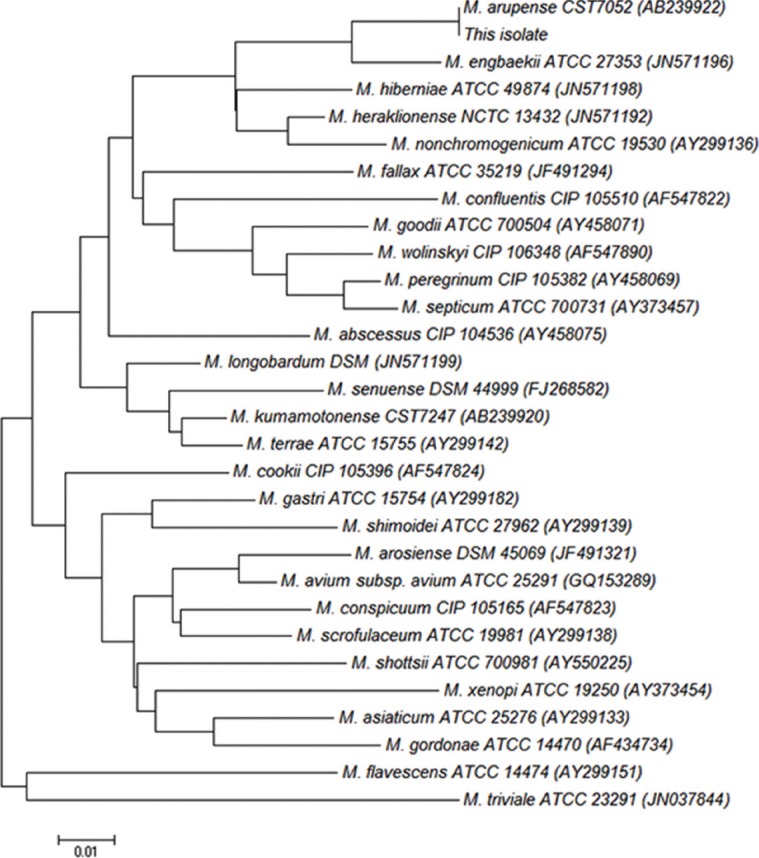Ann Lab Med.
2014 Jul;34(4):321-324. 10.3343/alm.2014.34.4.321.
First Korean Case of Mycobacterium arupense Tenosynovitis
- Affiliations
-
- 1Department of Laboratory Medicine, Seoul National University College of Medicine, Seoul, Korea. trust99@snu.ac.kr
- 2Department of Laboratory Medicine and Research Institute of Bacterial Resistance, Severance Hospital, Yonsei University College of Medicine, Seoul, Korea.
- KMID: 1791942
- DOI: http://doi.org/10.3343/alm.2014.34.4.321
Abstract
- No abstract available.
MeSH Terms
-
Anti-Bacterial Agents/pharmacology
DNA, Bacterial/analysis
Female
Humans
Hypertrophy/diagnosis
Magnetic Resonance Imaging
Microbial Sensitivity Tests
Middle Aged
Mycobacterium/classification/drug effects/*isolation & purification
Nontuberculous Mycobacteria/classification/drug effects/isolation & purification
Phylogeny
RNA, Ribosomal, 16S/chemistry/metabolism
Real-Time Polymerase Chain Reaction
Republic of Korea
Sequence Analysis, RNA
Sequence Homology, Nucleic Acid
Tenosynovitis/*diagnosis/microbiology/pathology
Anti-Bacterial Agents
DNA, Bacterial
RNA, Ribosomal, 16S
Figure
Reference
-
1. Cloud JL, Meyer JJ, Pounder JI, Jost KC JR, Sweeney A, Carroll KC, et al. Mycobacterium arupense sp. nov., a non-chromogenic bacterium isolated from clinical specimens. Int J Syst Evol Microbiol. 2006; 56:1413–1418. PMID: 16738122.2. Kazda J, Cooney R, Monaghan M, Quinn PJ, Stackebrandt E, Dorsch M, et al. Mycobacterium hiberniae sp. nov. Int J Syst Bacteriol. 1993; 43:352–357. PMID: 7684243.3. Mun HS, Park JH, Kim H, Yu HK, Park YG, Cha CY, et al. Mycobacterium senuense sp. nov., a slowly growing, non-chromogenic species closely related to the Mycobacterium terrae complex. Int J Syst Evol Microbiol. 2008; 58:641–646. PMID: 18319471.4. Tortoli E, Gitti Z, Klenk HP, Lauria S, Mannino R, Mantegani P, et al. Survey of 150 strains belonging to the Mycobacterium terrae complex and description of Mycobacterium engbaekii sp. nov., Mycobacterium heraklionense sp. nov. and Mycobacterium longobardum sp. nov. Int J Syst Evol Microbiol. 2013; 63:401–411. PMID: 22447702.5. Masaki T, Ohkusu K, Hata H, Fujiwara N, Iihara H, Yamada-Noda M, et al. Mycobacterium kumamotonense sp. nov. recovered from clinical specimen and the first isolation report of Mycobacterium arupense in Japan: Novel slowly growing, nonchromogenic clinical isolates related to Mycobacterium terrae complex. Microbiol Immunol. 2006; 50:889–897. PMID: 17116985.6. Griffith DE, Aksamit T, Brown-Elliott BA, Catanzaro A, Daley C, Gordin F, et al. An official ATS/IDSA statement: diagnosis, treatment, and prevention of nontuberculous mycobacterial diseases. Am J Respir Crit Care Med. 2007; 175:367–416. PMID: 17277290.
Article7. Smith DS, Lindholm-Levy P, Huitt GA, Heifets LB, Cook JL. Mycobacterium terrae: case reports, literature review, and in vitro antibiotic susceptibility testing. Clin Infect Dis. 2000; 30:444–453. PMID: 10722426.8. Hong SK, Sung JY, Lee HJ, Oh MD, Park SS, Kim EC. First case of Mycobacterium longobardum infection. Ann Lab Med. 2013; 33:356–359. PMID: 24003427.9. Milne BW, Arnold MH, Hudson B, Coolican MR. Infectious arthritis of the knee caused by Mycobacterium terrae: a case report. J Orthop Surg (Hong Kong). 2009; 17:103–108. PMID: 19398805.10. Tsai TF, Lai CC, Tsai IC, Chang CH, Hsiao CH, Hsueh PR. Tenosynovitis caused by Mycobacterium arupense in a patient with diabetes mellitus. Clin Infect Dis. 2008; 47:861–863. PMID: 18713040.11. Senda H, Muro H, Terada S. Flexor tenosynovitis caused by Mycobacterium arupense. J Hand Surg Eur Vol. 2011; 36:72–73. PMID: 21169302.12. Legout L, Ettahar N, Massongo M, Veziris N, Ajana F, Beltrand E, et al. Osteomyelitis of the wrist caused by Mycobacterium arupense in an immunocompetent patient: a unique case. Int J Infect Dis. 2012; 16:e761–e762. PMID: 22809581.13. Heidarieh P, Hashemi-Shahraki A, Khosravi AD, Zaker-Boustanabad S, Shojaei H, Feizabadi MM. Mycobacterium arupense infection in HIV-infected patients from Iran. Int J STD AIDS. 2013; 24:485–487. PMID: 23970753.14. Neonakis IK, Gitti Z, Kontos F, Baritaki S, Petinaki E, Baritaki M, et al. Mycobacterium arupense pulmonary infection: antibiotic resistance and restriction fragment length polymorphism analysis. Indian J Med Microbiol. 2010; 28:173–176. PMID: 20404471.15. Böddinghaus B, Rogall T, Flohr T, Blöcker H, Böttger EC. Detection and identification of mycobacteria by amplification of rRNA. J Clin Microbiol. 1990; 28:1751–1759. PMID: 2203812.
Article16. Kirschner P, Springer B, Vogel U, Meier A, Wrede A, Kiekenbeck M, et al. Genotypic identification of mycobacteria by nucleic acid sequence determination: report of a 2-year experience in a clinical laboratory. J Clin Microbiol. 1993; 31:2882–2889. PMID: 7505291.
Article17. Kim HY, Kook Y, Yun YJ, Park CG, Lee NY, Shim TS, et al. Proportions of Mycobacterium massiliense and Mycobacterium bolletii strains among Korean Mycobacterium chelonae-Mycobacterium abscessus group isolates. J Clin Microbiol. 2008; 46:3384–3390. PMID: 18753344.18. Clinical and Laboratory Standards Institute (CLSI). Susceptiblility testing of Mycobaceria, Nocardiae, and other aerobic Actinomycetes; approved standard, M24-A2. 2nd ed. Wayne, PA: Clinical and Laboratory Standards Institute;2011.
- Full Text Links
- Actions
-
Cited
- CITED
-
- Close
- Share
- Similar articles
-
- Nontuberculous Mycobacterial Tenosynovitis in the Hand: Two Case Reports with the MR Imaging Findings
- A Case of Mycobacterium Marinum Tenosynovitis Diagnosed by the PCR-restriction Fragment Length Polymorphism of the rpoB Gene
- Tuberculous Tenosynovitis of Hand (A Case Report)
- Marjolin's Ulcer Secondary to Tuberculous Tenosynovitis of the Wrist: A Case Report
- Mycobacterium intracellulare Tenosynovitis with Rice Body Formation with Literature Review


